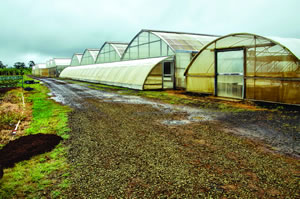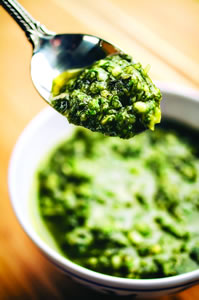Sweet Basil Time, Oh Oh Oh …
Kaua’i Fresh Farms is owned by Bill and Joan Porter, and located at the 500-acre Wai Koa Plantation in Kilauea. The hydroponic farm provides year-round growing conditions, and reduces water usage because it is not dispersed over a field. Using organic methods whenever possible, Kaua’i Fresh Farms grows tomatoes, cucumbers, sweet basil and lettuce in solar-powered greenhouses.The farm now offers tours, and Susan Elliott-Hubbard will guide you in an electric cart. You’ll see the country’s largest mahogany hardwood plantation, as well as organic gardens, a permaculture egg and vegetable farm, koi ponds, and the Historic Kilauea Stone Dam.
What’s growing: Apple bananas, basil, broccoli, corn (non GMO), Italian eggplant, Japanese cucumber, mixed lettuce, papaya, tomatoes.
SWEET BASIL
There are more than 150 species of basil including Thai, purple, cinnamon and lemon. Sweet basil, also known as Genovese, Napoletano or Italian large leaf basil, has smooth, medium to large leaves that are sweetly flavored.
Sweet basil’s scent is complex, sweet and spicy.
Each time you take a sniff or nibble, different elements reveal themselves. First you might smell clove, then anise, citrus or a good dose of mint.
In March 2009, I took a 12-week organic farming course taught by Jillian Seals. On harvest day, my favorite job was to pick basil. The plants grow 2 to 3 feet tall, and each time I pinched right above a leaf pair, the spicy vibrant, scent captured my heart, and I imagined the bundles would make a wonderful bridal bouquet.
Season: Basil loves heat, and dislikes a lot of moisture, that’s why it thrives in Mediterranean-like climates. On Kaua’i, basil thrives in the spring, summer and fall months. It will grow in the winter, but the excess moisture will make it susceptible to pests and disease.What to look for: Choose fresh basil over dried since it is superior in flavor. The leaves of fresh basil should look vibrant and be deep-green in color. They should be free from dark spots or yellowing.
Storage: Basil can be tricky to store because it blackens if too cold and wilts if too warm. Line a heavy, resealable plastic bag with a paper towel, and store in the vegetable crisper of your refrigerator where it should keep for one week.
Tip: Dried basil stems are aromatic, and can be used in place of wood chips in a smoker or on the barbecue. They give a subtle smoke flavor to vegetables, chicken, fish and cheese.
Preparation: Fresh herbs elevate most dishes. The oils are highly volatile, so they should be added near the end of the cooking process. If you have a lot of basil, puree it with olive oil and freeze the mixture in ice cube trays. Slip the cubes in salad dressings, sandwiches, soups, tomato sauces, cream cheese, sauteed zucchini, glazed carrots, steamed green beans, roasted red peppers, or eggplant ragout. In the cooler months, defrost the cubes and top halved tomatoes before baking.
Add chopped basil, finely grated Parmesan cheese and salt and pepper to olive oil for a magnificent dipping sauce for fresh-baked bread.In desserts, basil’s clove and mint flavors pair well with mango, pineapple and mountain apples. Add chopped basil to fruit fillings for turnovers, fruit crisps or cobbler. A small amount of fresh ginger, cinnamon or anise will amplify basil’s own sweet spice.
Health benefits: There are two water-soluble flavonoids (orientin and vicenin) found in basil that protect cell structure from radiation and oxygen-based damage. Basil has anti bacterial properties, and is a very good source of vitamin A and beta-carotene. These antioxidants protect the blood vessels from free radical damage, and help to prevent free radicals from oxidizing cholesterol in the blood stream.
Kauai Fresh Farms’ produce can be found at: Farmers Markets: Kapa’a (Wednesdays at 3 p.m.) Call 826-0077, or visit KauaiFreshFarms.com for the 12 retail outlets that sell their produce.
MAC NUT PESTO
Pesto is the most sublime of the herb sauces, and the best way to preserve the complex flavor of basil. It will keep for up to a month in the refrigerator, or six months in the freezer. The traditional Italian recipe calls for pine nuts, but I find macadamia nuts make a superb substitution.
* 2 cloves garlic, peeled and minced
* 3 ounces basil leaves, (about 3 cups gently packed)
* 1/4 cup macadamia nuts
* 1/2 cup extra virgin olive oil
* 1/2 cup ParmigianoReggiano, grated
* 1/4 teaspoon sea salt
Toss with cooked pasta, or add a dollop to grilled fish, baked potato, to enrich a bean soup or in place of tomato sauce on pizza.







